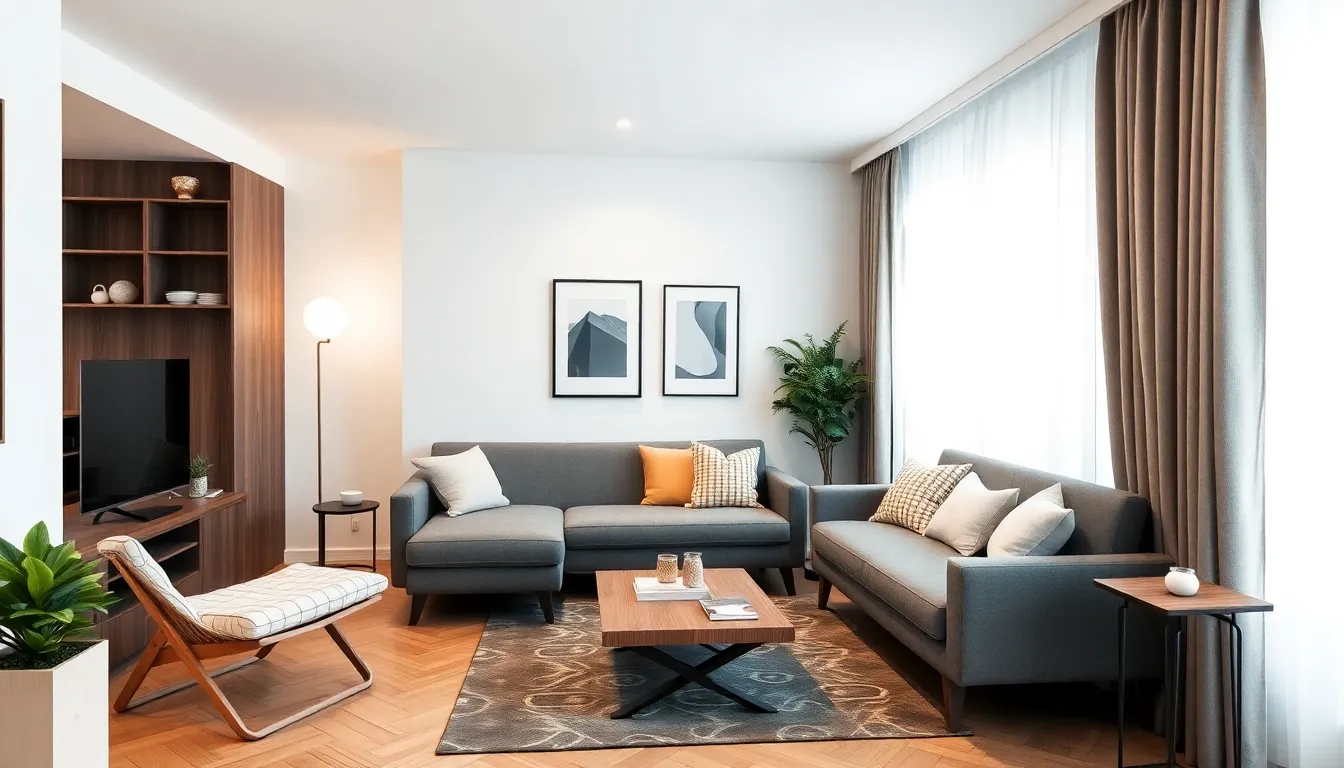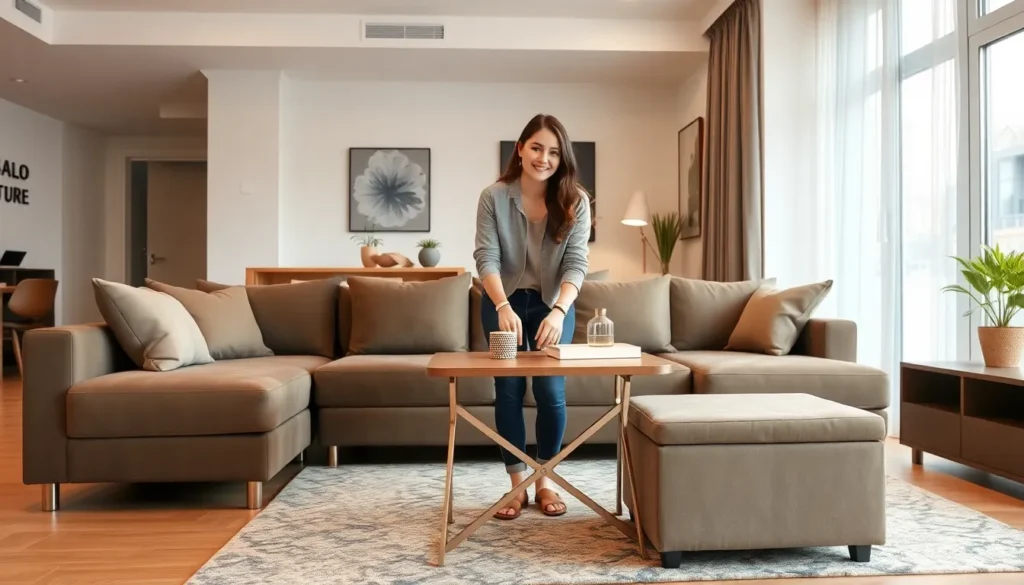Table of Contents
ToggleIn an era where urban living spaces are shrinking, space-saving furniture has emerged as a game-changer for homeowners and renters alike. These innovative designs maximize functionality without compromising style, making them essential for anyone looking to optimize their living areas.
From multifunctional sofas to foldable tables, space-saving furniture offers practical solutions that cater to modern lifestyles. Whether it’s a compact studio apartment or a cozy home office, these versatile pieces transform spaces into efficient havens. Discover how smart design can enhance comfort while keeping clutter at bay, proving that less truly can be more.
Overview of Space-Saving Furniture
Space-saving furniture efficiently utilizes limited square footage while enhancing aesthetics. Such furniture includes designs that serve dual functions, making it invaluable for smaller living spaces.
Types of Space-Saving Furniture
- Multifunctional Sofas: Sofas that convert into beds provide versatility for guests without occupying extra space.
- Foldable Tables: Tables that collapse or expand accommodate both daily use and special events.
- Nestable Furniture: Chairs or tables that stack or tuck away streamline storage, reducing clutter.
- Convertible Desks: Desks that transform into compact units help optimize workspace in home offices.
Benefits of Space-Saving Furniture
- Maximizes Space: Every inch matters in small areas, and space-saving designs enhance utility without sacrificing style.
- Reduces Clutter: Compact furniture minimizes disorder by offering smart storage solutions.
- Encourages Functional Living: Thoughtful design makes daily activities easier, promoting a seamless lifestyle.
Trends in Space-Saving Furniture
- Sustainable Materials: Eco-friendly options appeal to environmentally conscious consumers.
- Minimalist Aesthetic: Clean lines and simple designs attract those seeking modern elegance.
- Smart Technology Integration: Tech-savvy solutions, such as adjustable height tables, enhance user experience in small spaces.
Space-saving furniture addresses the needs of urban dwellers by blending functionality, style, and practicality, establishing itself as an integral aspect of modern interior design.
Benefits of Space-Saving Furniture

Space-saving furniture delivers multiple advantages, particularly for those living in smaller environments. By utilizing innovative designs, these items not only dazzle but also serve practical needs effectively.
Maximizing Small Spaces
Maximizing small spaces becomes straightforward with space-saving furniture. These pieces enable efficient use of limited square footage. Multi-purpose items like sofa beds or expandable dining tables adapt to different activities without hindering movement. Foldable chairs and tables provide options for guests while ensuring convenient storage when not in use. Designers often incorporate smart solutions, such as hidden compartments, allowing homeowners to conceal clutter effectively and maintain a tidy ambiance.
Enhancing Functionality
Enhancing functionality is another significant benefit of space-saving furniture. The incorporation of modular units allows customization based on individual needs and available space. Convertible desks offer work surfaces that change size or shape, accommodating various tasks from study sessions to home office setups. Storage ottomans blend style and utility, providing a place to relax while offering space for blankets or books. This adaptability encourages users to engage their spaces fully, embracing a lifestyle that promotes efficiency and practical living.
Types of Space-Saving Furniture
Space-saving furniture encompasses various designs that optimize living areas without sacrificing style or functionality. Key types include foldable options and multi-functional designs.
Foldable and Collapsible Options
Foldable and collapsible furniture provides flexibility and ease of storage.
- Foldable chairs: These lightweight seats fold flat for transport or storage, making them ideal for gatherings.
- Collapsible tables: These tables adapt to different sizes, accommodating both small and larger groups as needed.
- Murphy beds: Wall-mounted beds fold away during the day, freeing up valuable floor space while providing a comfortable sleeping arrangement at night.
- Folding desks: Compact and easy to stow, these desks allow for workspace expansion only when needed.
Each type ensures efficient utilization of space for varied activities while maintaining a sleek appearance.
Multi-Functional Designs
Multi-functional furniture maximizes utility by serving multiple purposes within the same piece.
- Sofa beds: These pieces transition from comfortable seating to a bed, perfect for accommodating overnight guests.
- Storage ottomans: Offering both seating and hidden storage, these pieces help keep clutter at bay while enhancing décor.
- Convertible dining tables: These tables can adjust in size, allowing transition from intimate meals to larger gatherings effortlessly.
- Desk and shelf combos: Combining workspace with storage or display areas, these designs maximize vertical and horizontal space efficiently.
Multi-functional designs epitomize versatility, making them ideal for small living environments where every inch counts.
Materials Used in Space-Saving Furniture
Space-saving furniture utilizes a variety of materials that balance aesthetics and durability, enhancing its functionality in compact living spaces.
Wood and Metal Choices
Wood and metal consistently dominate the structural framework of space-saving furniture.
- Wood:
- Wood provides warmth and character, with options like oak, maple, and plywood often used for their sturdiness and appeal.
- Birch offers a lightweight alternative without sacrificing strength, ideal for foldable designs.
- Metal:
- Metal, including steel and aluminum, adds resilience and a contemporary touch to furniture.
- Steel’s durability supports heavy usage, while aluminum’s lightweight nature promotes easy mobility in spaces.
- Combination Materials:
- Combining wood and metal creates a modern aesthetic while ensuring structural integrity.
- Offers hybrid designs for enhanced functionality, such as tables featuring metal frames with wooden surfaces.
Eco-Friendly Alternatives
Eco-friendly materials enhance the appeal of space-saving furniture by catering to environmentally conscious consumers.
- Reclaimed Wood:
- Reclaimed wood repurposes materials, reducing waste and promoting sustainability while offering unique character and history.
- Bamboo:
- Bamboo serves as a strong, renewable alternative that grows rapidly and requires minimal resources, making it an excellent choice for eco-friendly designs.
- Recycled Metals:
- Recycled metals minimize resource extraction and energy consumption, contributing to a more sustainable manufacturing process.
- Low-VOC Finishes:
- Low-VOC (volatile organic compound) finishes improve indoor air quality, promoting healthier living environments without compromising on style.
By using these materials, manufacturers effectively combine functionality with sustainable practices, aligning with the growing demand for environmentally responsible furnishings.
Tips for Choosing the Right Space-Saving Furniture
- Evaluate your space. Measure the dimensions of the area to accommodate furniture without cluttering. Identify the intended use, ensuring the piece fits the overall layout.
- Consider multifunctionality. Opt for items that serve multiple purposes, such as a sofa bed or an ottoman with storage. This approach maximizes utility while minimizing the number of furniture pieces.
- Prioritize comfort. Select furniture that doesn’t compromise on comfort despite its compact design. Look for quality materials and ergonomic features that enhance user experience.
- Select the right materials. Choose durable materials that align with personal style and functionality. Wood, metal, or eco-friendly options, like bamboo or reclaimed materials, offer various aesthetic choices.
- Assess functionality. Explore furniture with hidden features, such as expandable tables or foldable chairs, to ensure versatility. Verify that mechanisms for transformation function smoothly and remain reliable.
- Match your style. Ensure chosen furniture complements existing decor. Consider design elements, colors, and finishes that harmonize with the room’s overall theme.
- Check for storage capacity. Opt for pieces that provide additional storage. Storage ottomans, nested tables, or bookshelves with integrated compartments enhance organization and reduce clutter.
- Test before buying. Experience the furniture in-person to ensure quality and comfort. Sit, recline, or manipulate features to confirm its suitability for use in daily life.
- Research trends. Stay updated on the latest innovations in space-saving designs. Explore options that incorporate smart technology for added convenience and functionality.
- Plan for the future. Consider furniture that adapts to changing needs over time. Select items that remain functional as lifestyle or living conditions evolve, ensuring long-term practicality.
Space-saving furniture is more than just a trend; it’s a necessity for modern living. As urban spaces continue to shrink, the demand for innovative solutions grows. These versatile designs not only enhance functionality but also promote a clutter-free environment.
With options ranging from multifunctional sofas to foldable tables, individuals can create comfortable and efficient living areas, regardless of size. The blend of style and practicality ensures that these pieces fit seamlessly into any decor while serving multiple purposes.
As lifestyles evolve, embracing space-saving furniture allows residents to adapt to changing needs without sacrificing comfort or aesthetics. This approach to design truly embodies the principle that thoughtful choices can lead to a more harmonious living space.





